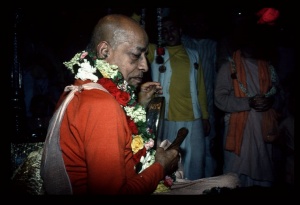CC Adi 11.32: Difference between revisions
m (1 revision(s)) |
No edit summary |
||
| Line 1: | Line 1: | ||
{{ | [[Category:Sri Caitanya-caritamrta - Adi-lila Chapter 11|C032]] | ||
<div style="float:left">'''[[Sri Caitanya-caritamrta|Śrī Caitanya-caritāmṛta]] - [[CC Adi|Ādi-līlā]] - [[CC Adi 11|Chapter 11: The Expansions of Lord Nityānanda]]'''</div> | |||
<div style="float:right">[[File:Go-previous.png|link=CC Adi 11.31|Ādi-līlā 11.31]] '''[[CC Adi 11.31|Ādi-līlā 11.31]] - [[CC Adi 11.33|Ādi-līlā 11.33]]''' [[File:Go-next.png|link=CC Adi 11.33|Ādi-līlā 11.33]]</div> | |||
{{CompareVersions|CC|Adi 11.32|CC 1975|CC 1996}} | |||
{{RandomImage}} | |||
==== TEXT 32 ==== | ==== TEXT 32 ==== | ||
<div | <div class="verse"> | ||
maheśa paṇḍita—vrajera udāra gopāla | :maheśa paṇḍita—vrajera udāra gopāla | ||
ḍhakkā-vādye nṛtya kare preme mātoyāla | :ḍhakkā-vādye nṛtya kare preme mātoyāla | ||
</div> | </div> | ||
| Line 12: | Line 16: | ||
==== SYNONYMS ==== | ==== SYNONYMS ==== | ||
<div | <div class="synonyms"> | ||
maheśa | ''maheśa paṇḍita''—Maheśa Paṇḍita; ''vrajera''—of Vṛndāvana; ''udāra''—very liberal; ''gopāla''—cowherd boy; ''ḍhakkā-vādye''—with the beating of a kettledrum; ''nṛtya kare''—used to dance; ''preme''—in love; ''mātoyāla''—as if a madman. | ||
</div> | </div> | ||
| Line 19: | Line 23: | ||
==== TRANSLATION ==== | ==== TRANSLATION ==== | ||
<div | <div class="translation"> | ||
Maheśa Paṇḍita, the seventh of the twelve gopālas, was very liberal. In great love of Kṛṣṇa he danced to the beating of a kettledrum like a madman. | Maheśa Paṇḍita, the seventh of the twelve gopālas, was very liberal. In great love of Kṛṣṇa he danced to the beating of a kettledrum like a madman. | ||
</div> | </div> | ||
| Line 26: | Line 30: | ||
==== PURPORT ==== | ==== PURPORT ==== | ||
<div | <div class="purport"> | ||
Śrīla Bhaktisiddhānta Sarasvatī Ṭhākura writes in his Anubhāṣya, “The village of Maheśa Paṇḍita, which is known as Pālapāḍā, is situated in the district of Nadia within a forest about one mile south of the Cākadaha railway station. The Ganges flows nearby. It is said that formerly Maheśa Paṇḍita lived on the eastern side of Jirāṭ in the village known as Masipura or Yaśīpura, and when Masipura merged into the riverbed of the Ganges, the Deities there were brought to Pālapāḍā, which is situated in the midst of various villages such as Beleḍāṅgā, Berigrāma, Sukhasāgara, Cānduḍe and Manasāpotā. (There are about fourteen villages, and the entire neighborhood is known as Pāñcanagara Paragaṇā.) It is mentioned that Maheśa Paṇḍita joined the festival performed by Śrī Nityānanda Prabhu at Pānihāṭi. Narottama dāsa Ṭhākura also joined in the festival, and Maheśa Paṇḍita saw him on that occasion. In the temple of Maheśa Paṇḍita there are Deities of Gaura-Nityānanda, Śrī Gopīnātha, Śrī Madana-mohana and Rādhā-Govinda, as well as a śālagrāma-śilā.” | Śrīla Bhaktisiddhānta Sarasvatī Ṭhākura writes in his ''Anubhāṣya'', “The village of Maheśa Paṇḍita, which is known as Pālapāḍā, is situated in the district of Nadia within a forest about one mile south of the Cākadaha railway station. The Ganges flows nearby. It is said that formerly Maheśa Paṇḍita lived on the eastern side of Jirāṭ in the village known as Masipura or Yaśīpura, and when Masipura merged into the riverbed of the Ganges, the Deities there were brought to Pālapāḍā, which is situated in the midst of various villages such as Beleḍāṅgā, Berigrāma, Sukhasāgara, Cānduḍe and Manasāpotā. (There are about fourteen villages, and the entire neighborhood is known as Pāñcanagara Paragaṇā.) It is mentioned that Maheśa Paṇḍita joined the festival performed by Śrī Nityānanda Prabhu at Pānihāṭi. Narottama dāsa Ṭhākura also joined in the festival, and Maheśa Paṇḍita saw him on that occasion. In the temple of Maheśa Paṇḍita there are Deities of Gaura-Nityānanda, Śrī Gopīnātha, Śrī Madana-mohana and Rādhā-Govinda, as well as a ''śālagrāma-śilā''.” | ||
</div> | </div> | ||
__NOTOC__ | |||
<div style="float:right; clear:both;">[[File:Go-previous.png|link=CC Adi 11.31|Ādi-līlā 11.31]] '''[[CC Adi 11.31|Ādi-līlā 11.31]] - [[CC Adi 11.33|Ādi-līlā 11.33]]''' [[File:Go-next.png|link=CC Adi 11.33|Ādi-līlā 11.33]]</div> | |||
__NOTOC__ | |||
__NOEDITSECTION__ | |||
Revision as of 03:50, 22 July 2021

A.C. Bhaktivedanta Swami Prabhupada
TEXT 32
- maheśa paṇḍita—vrajera udāra gopāla
- ḍhakkā-vādye nṛtya kare preme mātoyāla
SYNONYMS
maheśa paṇḍita—Maheśa Paṇḍita; vrajera—of Vṛndāvana; udāra—very liberal; gopāla—cowherd boy; ḍhakkā-vādye—with the beating of a kettledrum; nṛtya kare—used to dance; preme—in love; mātoyāla—as if a madman.
TRANSLATION
Maheśa Paṇḍita, the seventh of the twelve gopālas, was very liberal. In great love of Kṛṣṇa he danced to the beating of a kettledrum like a madman.
PURPORT
Śrīla Bhaktisiddhānta Sarasvatī Ṭhākura writes in his Anubhāṣya, “The village of Maheśa Paṇḍita, which is known as Pālapāḍā, is situated in the district of Nadia within a forest about one mile south of the Cākadaha railway station. The Ganges flows nearby. It is said that formerly Maheśa Paṇḍita lived on the eastern side of Jirāṭ in the village known as Masipura or Yaśīpura, and when Masipura merged into the riverbed of the Ganges, the Deities there were brought to Pālapāḍā, which is situated in the midst of various villages such as Beleḍāṅgā, Berigrāma, Sukhasāgara, Cānduḍe and Manasāpotā. (There are about fourteen villages, and the entire neighborhood is known as Pāñcanagara Paragaṇā.) It is mentioned that Maheśa Paṇḍita joined the festival performed by Śrī Nityānanda Prabhu at Pānihāṭi. Narottama dāsa Ṭhākura also joined in the festival, and Maheśa Paṇḍita saw him on that occasion. In the temple of Maheśa Paṇḍita there are Deities of Gaura-Nityānanda, Śrī Gopīnātha, Śrī Madana-mohana and Rādhā-Govinda, as well as a śālagrāma-śilā.”